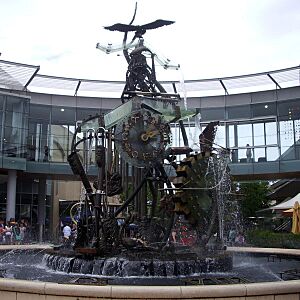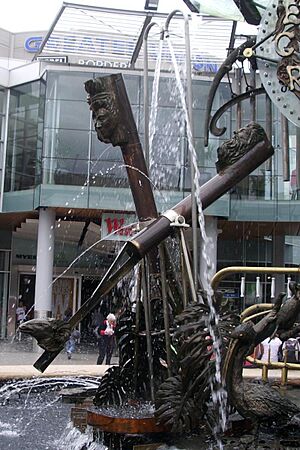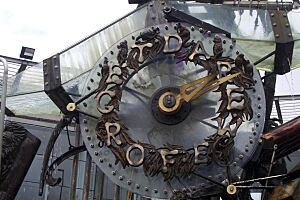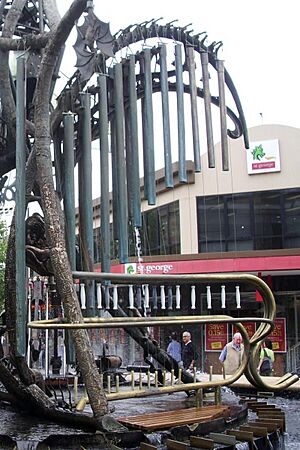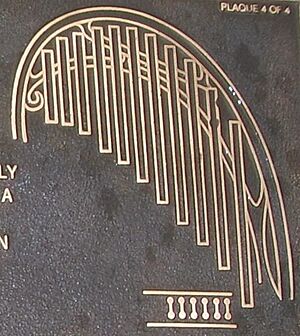Hornsby Water Clock facts for kids
The Hornsby Water Clock, also known as Man, Time and the Environment, is a special kind of moving sculpture. It's also a beautiful fountain and a working clock. You can find it in the Florence Street pedestrian area in Hornsby, Australia.
This amazing sculpture was first shown in 1993. It was designed by Victor Cusack and built by him and Rex Feakes. They used bronze, stainless steel, and glass. Building it cost over A$1 million and took two and a half years! At first, things like chicken bones caused problems, but the water filter was later made better.
Contents
What is the Hornsby Water Clock?
Many people think this clock has been in Hornsby for a very long time, even though it was only revealed in 1993. It actually combines three different types of water clocks:
- A Greek clepsydra from the 4th century BC.
- A Chinese water wheel clock from the 11th century.
- A Swiss pendulum clock from the 17th century.
It also has a set of 17 bronze bells called a carillon. These bells ring the hour, based on a design from an old English church that is 250 years old.
The whole sculpture sits on a floating platform called a pontoon. This pontoon slowly turns every 12 hours. As it turns, a pointer moves past Roman numerals in the water, showing a fourth way to tell the time!
The sculpture is about 8 meters (26 feet) tall and weighs a huge 20 tons (about 44,000 pounds).
The Clock's Message
The Hornsby Water Clock has four special plaques on it. Three of them explain how the different clocks work. The first plaque tells us the main idea behind the whole sculpture.
It says that this moving water sculpture is a unique message about our environment. This message is very important for Hornsby, which has many beautiful natural areas with lots of plants and animals. The clock shows how humans have been creative and joyful throughout history. But it also reminds us that we are quickly losing our ability to live peacefully with almost all other forms of life on Earth.
The plaque suggests there's a big difference between the amazing things humans have invented (like these clocks) and the damage we are causing as the world's population grows. It celebrates the beauty of the local environment and reminds us that we need to be responsible for all living things, both human and animal.
The sculpture features many animals, including:
- Tawny frogmouth
- Rainbow lorikeet
- Pied cormorant
- Little penguin
- Australian pelican
- Water dragon
- Blue-tongued lizard
- Goanna
- Grey-headed flying fox
- Brushtail possum
- Sea eagle
- Human
How the Clocks Work
The Hornsby Water Clock is made up of several clever parts, each telling time in a different way.
Greek Clepsydra Clock
This type of clock works by water slowly filling a container. Water flows into a fixed pot from a tank that is always kept full. Because the water level in the supply tank stays the same, water flows out at a steady speed. The amount of water in the pot then shows how much time has passed.
In this clock, two tubes are balanced. When they fill with water, they tip over, emptying their water into the pond. Then, a counterweight (shaped like a ram's head) pulls them back up to start filling again. The top of each tube has a Hermaphrodite head decoration.
Chinese Water Wheel Clock
This clock has 20 buckets that can swing freely around a wheel that is 2.3 meters (7.5 feet) wide. Water from a full tank flows into one bucket. When the bucket gets heavy enough, it tips over, spilling its water. As it falls, it triggers a lever that releases a lock on the water wheel, allowing the wheel to turn a little. The lock then returns, stopping the wheel so the next empty bucket can fill up.
This design is based on a clock built by Su Song between 1088 and 1092.
Swiss Pendulum Clock
This is said to be the biggest water-powered pendulum clock ever built! Its pendulum swings back and forth every 4 seconds, just like the famous Great Clock of Westminster. However, its pendulum weight is much heavier, at 350 kilograms (770 pounds). The design comes from a drawing by Claude Perrault in 1669, but it was never built until now.
The 5-meter (16.4-foot) pendulum swings on a very thin edge to reduce rubbing. It is kept moving by water filling glass chutes at the top. As one side fills, it tilts the mechanism, emptying the water and sending it to the other side, under the sea eagle sculpture.
A glass wheel with 30 pins marks the seconds. Every half-swing of the pendulum (2 seconds), the wheel moves to the next pin, completing a full turn every minute. A special part on the "second wheel" releases a lever every 30 seconds. This releases 100 liters (26.4 US gallons) of water and moves the minute hand once a minute, and the hour hand once every 12 minutes.
Instead of numbers, the clock face has letters that spell out "Dare we forget". The clock also has different animals and aboriginal art. These remind us that many species are disappearing because of how we use the land. They also remember the strong tribal population of Hornsby that faced a similar fate.
The pendulum clock helps control the turning of the pontoon, the ringing of the chimes, and supplies water to the Chinese clock.
Pontoon Rotation Clock
The entire sculpture slowly turns because of the water swirling underneath it in a clockwise direction. A special "catch" device on the pontoon controls how fast it turns. This catch locks into one of 60 stops around the inner pond wall. Every 12 minutes, the pendulum clock releases the catch. This allows the pontoon to turn until it reaches the next stop.
Carillon or Chime Set
The carillon has 17 tubes made of bell-bronze. These bells chime automatically every hour, but you can also play them by hand. The way it works was invented by "Harringtons of Coventry" and seen by the sculptor in a church in Haywards Heath. This carillon is made of metal instead of wood and has 17 tubes, more than the usual 6 to 9. All the tubes together weigh about 1 ton (2,200 pounds). They can play notes from the octave above Middle C and some notes below.
Images for kids


